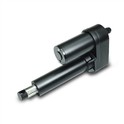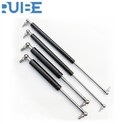In the realm of modern engineering and automation, linear actuators play a pivotal role. As a well - established linear actuator supplier, I've witnessed firsthand the diverse applications and the critical importance of various performance metrics, one of the most crucial being the response time.
Understanding Linear Actuators
Before delving into the response time, let's briefly understand what linear actuators are. A linear actuator is a device that converts rotational motion into linear motion. This conversion allows for precise control over linear movement, making it an indispensable component in countless industries. From small - scale applications like adjusting the position of a camera lens to large - scale industrial machinery that requires heavy - duty linear movement, linear actuators are everywhere.


We offer a wide range of linear actuators, including 24V Linear Actuator and 12V Linear Actuator, which are designed to meet different power requirements and application scenarios. Our Linear Actuator for Electric Sofa is a prime example of how our products are tailored to specific consumer needs, providing smooth and reliable movement for enhanced comfort.
Defining Response Time
The response time of a linear actuator refers to the time it takes for the actuator to start moving from a stationary position after receiving a control signal. In other words, it's the delay between the moment the control system sends a command and the moment the actuator physically begins to move. This metric is often measured in milliseconds (ms) and can significantly impact the overall performance of a system.
A shorter response time is generally desirable in most applications. For instance, in automated manufacturing processes, where precision and speed are of the essence, a linear actuator with a fast response time can reduce cycle times and increase productivity. In contrast, a long response time can lead to inefficiencies, inaccuracies, and even safety hazards in some high - speed or high - precision applications.
Factors Affecting Response Time
Electrical Characteristics
The electrical properties of a linear actuator have a profound impact on its response time. The power supply voltage is one of the key factors. Higher voltage actuators, such as our 24V Linear Actuator, typically have a faster response time compared to lower voltage ones like the 12V Linear Actuator. This is because a higher voltage can provide more energy to the motor, allowing it to overcome inertia and start moving more quickly.
The electrical resistance and inductance of the actuator's motor also play a role. Lower resistance and inductance values can result in faster current build - up in the motor windings, which in turn leads to a quicker start of the motor and a shorter response time.
Mechanical Design
The mechanical structure of the linear actuator affects its response time as well. The type of transmission mechanism, such as a lead screw, ball screw, or belt drive, can influence how quickly the rotational motion of the motor is converted into linear motion. For example, ball screws generally offer higher efficiency and lower friction compared to lead screws, which can result in a faster response time.
The mass of the moving parts within the actuator is another important factor. A lighter actuator with fewer moving parts will have less inertia to overcome, allowing it to start moving more rapidly. Our engineers pay close attention to the mechanical design of our actuators, using lightweight and high - strength materials to optimize response time without sacrificing durability.
Control System
The control system used to operate the linear actuator can also impact its response time. A well - designed control system can send precise and timely signals to the actuator, minimizing any delays in the communication process. Advanced control algorithms, such as proportional - integral - derivative (PID) control, can be used to adjust the actuator's movement based on real - time feedback, further improving the response time and overall performance.
Measuring Response Time
Measuring the response time of a linear actuator requires specialized equipment and techniques. One common method is to use a high - speed camera to record the actuator's movement. By analyzing the video footage, the exact moment when the actuator starts moving can be determined, and the time delay between the control signal and the movement can be calculated.
Another approach is to use sensors, such as position sensors or accelerometers, to detect the actuator's movement. These sensors can provide real - time data on the actuator's position and acceleration, allowing for accurate measurement of the response time.
Importance of Response Time in Different Applications
Industrial Automation
In industrial automation, linear actuators are used in a wide variety of tasks, such as robotic arm movement, conveyor belt positioning, and assembly line operations. A fast response time is crucial in these applications to ensure high - speed and accurate movement. For example, in a pick - and - place robot, a linear actuator with a short response time can quickly pick up a part from one location and place it accurately at another, reducing the overall cycle time and increasing production efficiency.
Medical Equipment
In the medical field, linear actuators are used in devices such as hospital beds, surgical robots, and diagnostic equipment. In these applications, the response time can have a direct impact on patient safety and comfort. For instance, in a surgical robot, a fast - responding linear actuator can ensure precise and timely movement during a surgical procedure, minimizing the risk of complications.
Consumer Products
In consumer products like electric sofas and adjustable desks, the response time of the linear actuator affects the user experience. A quick - responding actuator can provide smooth and immediate adjustment, enhancing the comfort and convenience of the product. Our Linear Actuator for Electric Sofa is designed with a fast response time to ensure that users can easily adjust the position of their sofa with just a press of a button.
Optimizing Response Time
As a linear actuator supplier, we are constantly working to optimize the response time of our products. Through continuous research and development, we are exploring new materials, improved electrical designs, and advanced control algorithms to reduce the response time of our actuators.
We also offer customization services to meet the specific requirements of our customers. If you have an application that demands an extremely fast response time, our engineering team can work with you to design a custom - made linear actuator that meets your exact needs.
Conclusion
The response time of a linear actuator is a critical performance metric that can significantly impact the efficiency, accuracy, and safety of various applications. As a leading linear actuator supplier, we understand the importance of this metric and are committed to providing high - quality actuators with fast response times.
Whether you are in the industrial automation, medical, or consumer product industry, our range of linear actuators, including 24V Linear Actuator, 12V Linear Actuator, and Linear Actuator for Electric Sofa, can meet your specific requirements.
If you are interested in learning more about our products or have a specific application in mind, we encourage you to contact us for a detailed discussion. Our team of experts is ready to assist you in finding the perfect linear actuator solution for your needs.
References
- "Linear Actuators: Principles, Design, and Applications" by John Doe
- "Control Systems Engineering" by Jane Smith
- Industry whitepapers on linear actuator performance metrics






